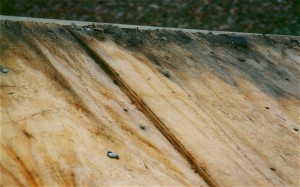Signature Roofing in Northern Virginia, is experienced in the various ventilation systems and can provide the best recommendation for your specific home.
There are two basic forms of ventilation systems available for residential homes. One form is the electric-powered attic fan which may be mounted inside the attic as a gable fan or more commonly, designed as a roof mounted exterior unit.
Electric-powered Attic Fans
Electric-powered fans are controlled by a thermostat which dictates the temperature at which the fan turns on and when the fan turns off. With proper intake sources, power fans can cycle the most amount of air through an attic on a hot day compared to a passive ventilation system. However, the thermostat settings often do not allow a fan to be set to run during the cooler months of the year, a time when moisture and condensation build-up is at its peak. While a humidistat control and owner-controlled thermostat bypass switches can be added for winter use, power fans are most effective during the peak summer months and provide the maximum personal comfort for the homeowner.
Passive Ventilation Systems
The second system is a passive ventilation using either wind-driven turbines to pull air out of an attic or a ridge vent system which uses the natural convection of warm air rising to exhaust air through a slot cut in the peak of the roof.
Passive ventilation systems work year round and provide an increased personal comfort level in the home during the summer months. Though not as effective as the electric-powered fans in reducing attic temperature during the hottest days, passive systems work year round without the use of electricity or owner involvement.
Working on the scientific principle that warm air rises, passive ridge vents exhaust air from the highest part of the attic where warm air collects. As warm air migrates upward, it collects the moist and humid air that also accumulates in the attic space. As it reaches the peak of the attic, it is exhausted outside the home and cooler air is drawn from the lower areas of the attic to replace it, and the cycle begins again.
When comparing ventilation systems, each has their advantages and disadvantages. We suggest you think of ventilation in terms of either “personal comfort” or “structural protection.” All exhaust systems work best when coupled with an adequate source of intake air. Many homes have traditional soffit vents which fills this need.
It is the moist attic air that can cause the most damage to the structural integrity of your roof. Without proper ventilation, moist attic air collects on the underside of the roof decking and can cause the decking to expand slightly. As the wood dries out, it contracts. If your home was built without the use of deck spacer clips, this cycle of expansion and contraction can cause the wood to warp over time or lead to premature wood fatigue.
Ventilation is an important area to remember when roofing. The attic must be well ventilated to ensure a good quality foundation for the roof.
Adequate ventilation can also help to prevent ice dam leakage during periods of ice and snow build-ups.


